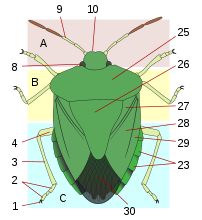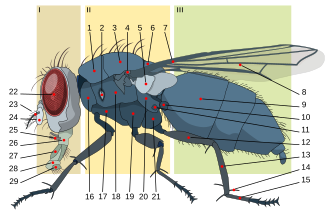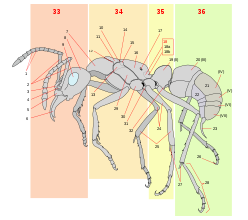
Back صدر الحشرة Arabic Грудзі беспазваночных Byelorussian Гърди (насекоми) Bulgarian Brusk (amprevaned) Breton Tòrax (artròpodes) Catalan ᎠᏰᎸ ᎦᎸᎳᏗᏟ CHR Hruď Czech Thorax (insektanatomi) Danish Thorax (Gliederfüßer) German Tórax (artrópodos) Spanish
The thorax is the midsection (tagma) of the hexapod body (insects and entognathans). It holds the head, legs, wings and abdomen. It is also called mesosoma or cephalothorax in other arthropods.
It is formed by the prothorax, mesothorax and metathorax and comprises the scutellum; the cervix, a membrane that separates the head from the thorax; and the pleuron, a lateral sclerite of the thorax.
In dragonflies and damselflies, the mesothorax and metathorax are fused together to form the synthorax.[1][2]
In some insect pupae, like the mosquitoes', the head and thorax can be fused in a cephalothorax.
Members of suborder Apocrita (wasps, ants and bees) in the order Hymenoptera have the first segment of the abdomen fused with the thorax, which is called the propodeum. The head is connected to the thorax by the occipital foramen, enabling a wide range of motion for the head.[3]
In most flying insects, the thorax allows for the use of asynchronous muscles.
- ^ Theischinger, Günther; Hawking, John (2006). The Complete Field Guide to Dragonflies of Australia. Collingwood, Victoria: CSIRO Publishing. p. 303. ISBN 978-0-643-09073-6.
- ^ Tillyard, R. J. (1917). The Biology of Dragonflies (PDF). Cambridge University Press. p. 20. Archived (PDF) from the original on July 3, 2017.
- ^ Legner, Elrich Fred. "General Summary of the Hymenoptera". An Introduction to the Study of Entomology.


